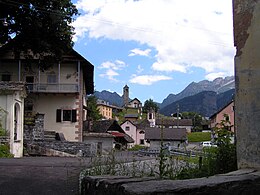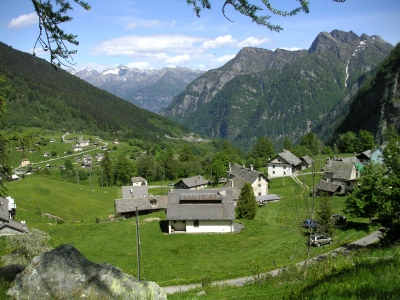Campo (Vallemaggia)
Campo (Valle Maggia )
Campo (Valle Maggia ) is a municipality in the district Rovana, in the district of Valle Maggia the canton of Ticino in Switzerland.
Geography
The municipality is located in the Val di Campo 42 km north-west of Locarno. The northern border of Bosco / Gurin runs along the ridges of a mountain range. The westernmost point of this chain is the Madone / Batnall ( 2'748 m above sea level), the easternmost point of Pizzo Bombögn ( 2'289 m asl). The western border of the Val Formazza is also border with Italy. It leads from the Madone / Batnall over to Pizzo Quadro ( 2'793 m above sea level), then divided in a southeasterly direction to the upper part of the Val di Campo, going in a south-westerly direction to Pizzo di Porcarese ( 2'467 m asl. ) and then turns to the east. The easternmost point is the Pizzo Molinera ( 2'292 m asl). The entire southern border is the same county line ( Distretto di Valle Maggia / Distretto di Locarno ) and usually leads along ridges of mountains. From the latter mountain it goes briefly to the northeast to Pizzo Alzasca ( 2,262 m asl), then west to Pizzo Mezzodi and then in a north -westerly direction back to Pizzo Bombögn. In the southern mountainous part three small lakes: Lago dei Pozzöi ( 1,955 m asl), the Lago di SfiI ( 1,909 m asl) and the Lago del Pezz ( 1,979 m above sea level. ). Main stream is the Rovana, the result of the merger of the Ri di SfiI ( rises in the south of the municipality ) and the Rio Colobiasca ( rises in the west of the municipality ) is created. In the town there are numerous groups of houses and farmsteads. The largest settlements are Pianelli ( a merger of several Alps; 1-1.8 km southwest of Campo), Cimalmotto ( 1,405 m above sea level, 800 m southwest of Campo), Campo (Valle Maggia ) ( 1'281 -1 '311 m above sea level, a merger of several hamlets), Piano di Campo ( 1,187 m above sea level, 1.7 km to the east of Campo) and Niva ( above the small brook; 1'073 m asl. ; 2.8 km east of Campo). All of these settlements are located north of Rovana. Of the total municipality area of over 43 square kilometers 44.3% of woods and forests covered 41.5% and unproductive area (mountains and lakes). At least 13.3 % of its territory to be used for agriculture. A further 0.8 % of the municipal area is urbanized area. However, a considerable part of the territory suffers from tectonic movements.
Population
Campo was a settlement of considerable size in the late Middle Ages. But already many people had to emigrate in the 17th and 18th century Germany and Italy because there were too few jobs and settlement area for all inhabitants. Therefore, the population halved 1683-1801 ( 1683-1801: -51.2 %). By the year 1850, the population stabilized, before the great exodus began, which lasted until 1990. For now, were the targets overseas ( California and Australia ) - but also hiked several residents in other parts of the canton of Ticino. Between 1683 and 1990, therefore, the number of residents decreased by 95.6 % (!) The highest value of all Ticino communities. The small upturn in the 1990s, has already slowed down again.
Languages
The people speak a local dialect of Italian. At the last census in 2000 gave 89.66 % speak Italian, 8.62% and 1.72 % German English as their primary language.
Religions - faiths
In earlier times, all the inhabitants were members of the Roman Catholic Church. Today ( as of 2000), this looks different. This is due to leaving the church and immigration from other parts of Switzerland and abroad. There are 81.03 % and 8.62% Roman Catholic Evangelical Protestant Christians. In addition, one finds 5.17% non-religious. Further 5.17% of the population did not specify their religious community.
Origin - Nationality
Of the 56 residents in late 2004 were 52 ( = 92.86 %), Swiss citizen. At the last census were 86.21 % of the population Swiss nationals, including a dual citizen. The aliens come with the exception of a Dutchman, all from Italy.
Personalities
- Family Pedrazzini
- Alberto Pedrazzini
- Giovan Battista Pedrazzini
- Martino Pedrazzini, Ticino Cantonal Parliament, State
- Michele Pedrazzini, Ticino cantonal parliament, the National Council
- Paolo Pedrazzini, National
- Luigi Pedrazzini, lawyer, State Council.
Attractions
- Parish Church of San Bernardo and Stations of the Cross. ,
- Palazzi Pedrazzini and oratorio San Giovanni Battista. ,
- Oratory of Santa Maria Addolorata
- In the district of " Cimalmotto " parish church of the Beata Vergine Assunta
- Oratory San Luigi Gonzaga
- In the district of " Niva ", Parish Church of San Rocco
- In the district of " Piano " Oratory of San Carlo Borromeo
- In the district of " Seccada " Oratory of Saint Anthony of Padua.
Policy
The council consists of three members.
Economy
Since the municipality does not provide large employment opportunities, immigrated in the 17th and 18th centuries, parts of the population as seasonal workers to Italy and Germany. In the 19th century it attracted many emigrants to Australia and California. Today, working from the 27 workers still 19 ( = 70.4 %) in their own community - mostly in agricultural occupations.
Traffic
The community is connected to the Postbus Cevio - Cerentino - Cimalmotto to the public transport network by a few Postbus courses per day (depending on day of week 3-4 ).
The road conditions are to its remoteness also not very good.








_2008.png/260px-Karte_Gemeinde_Campo_(Vallemaggia)_2008.png)